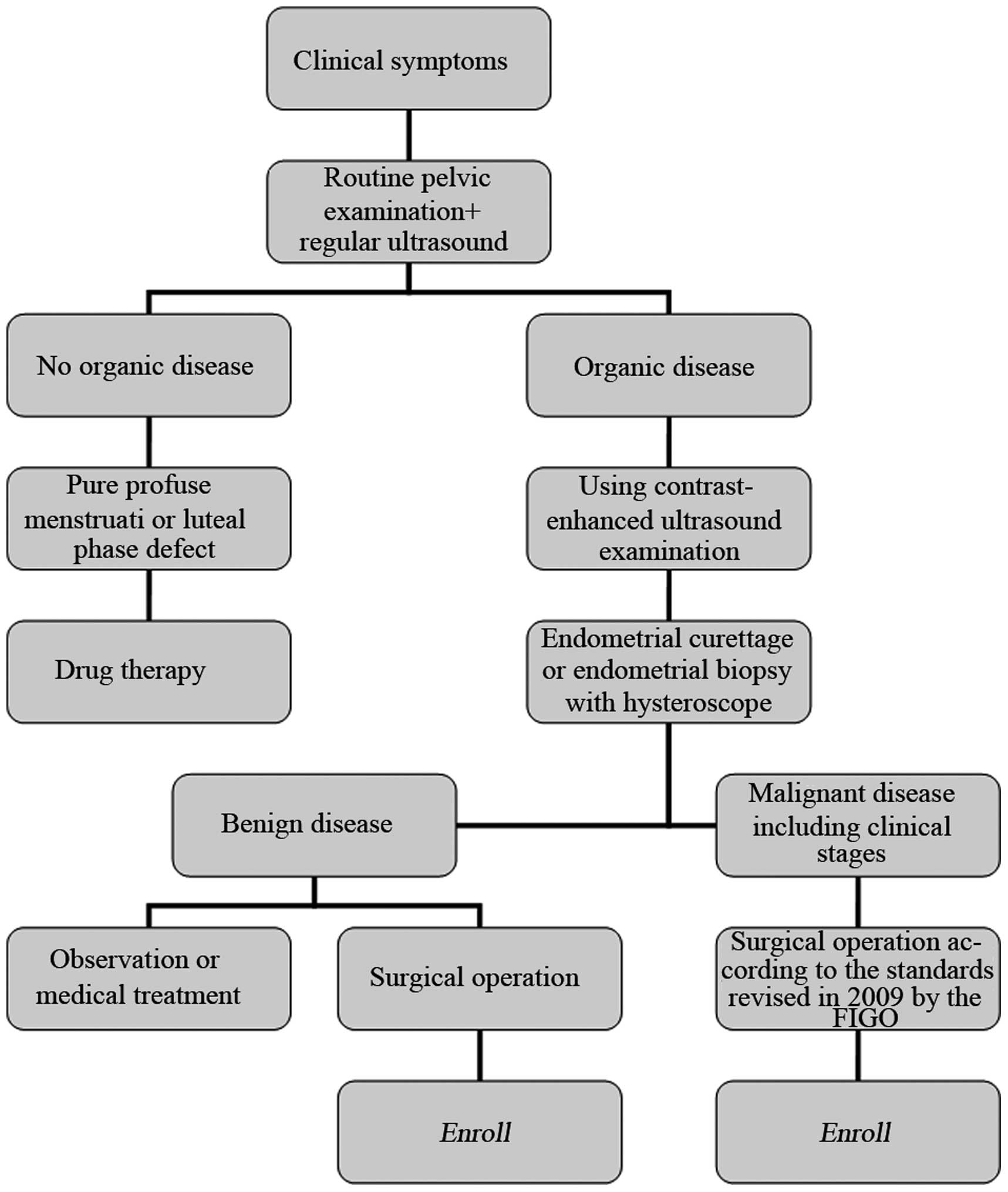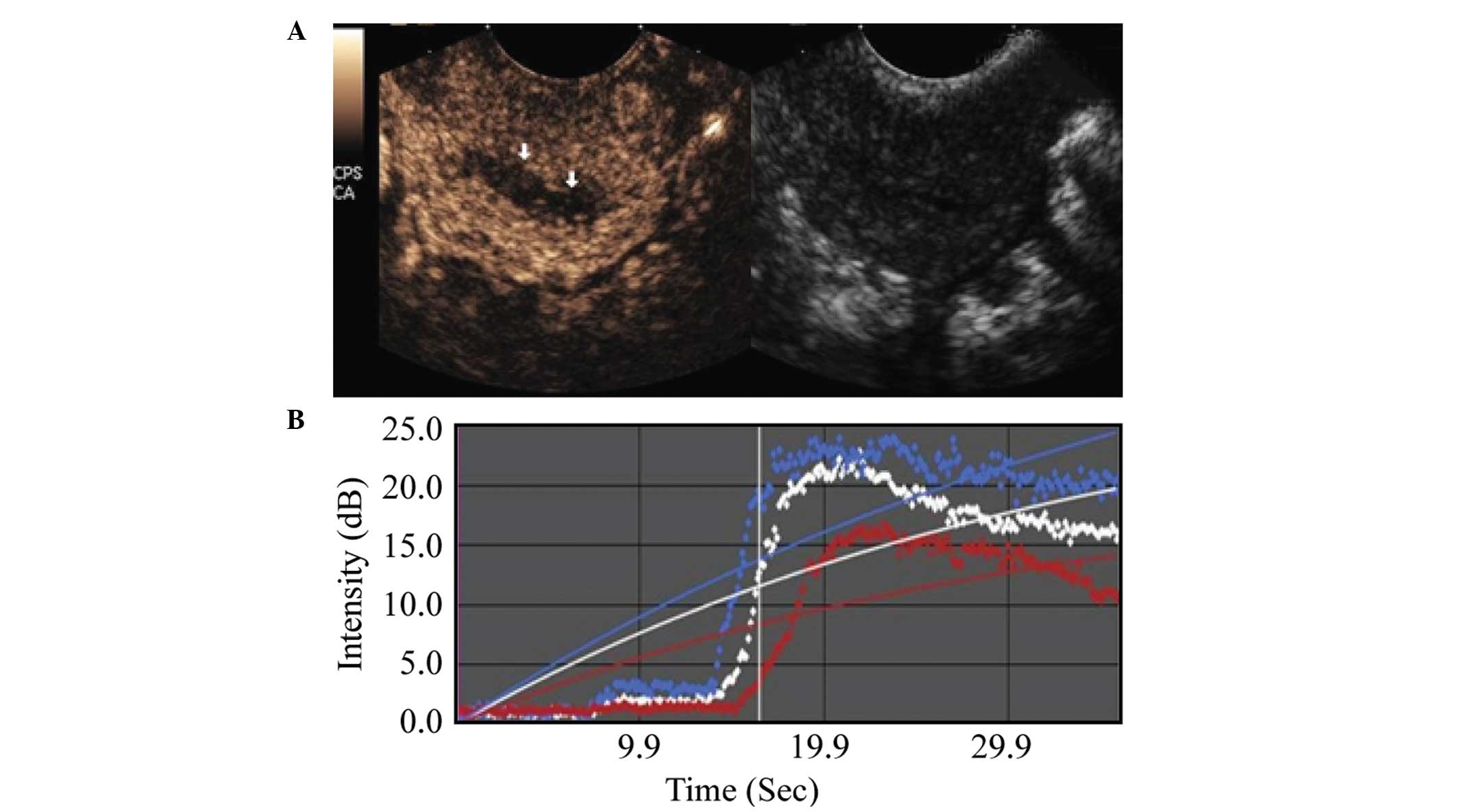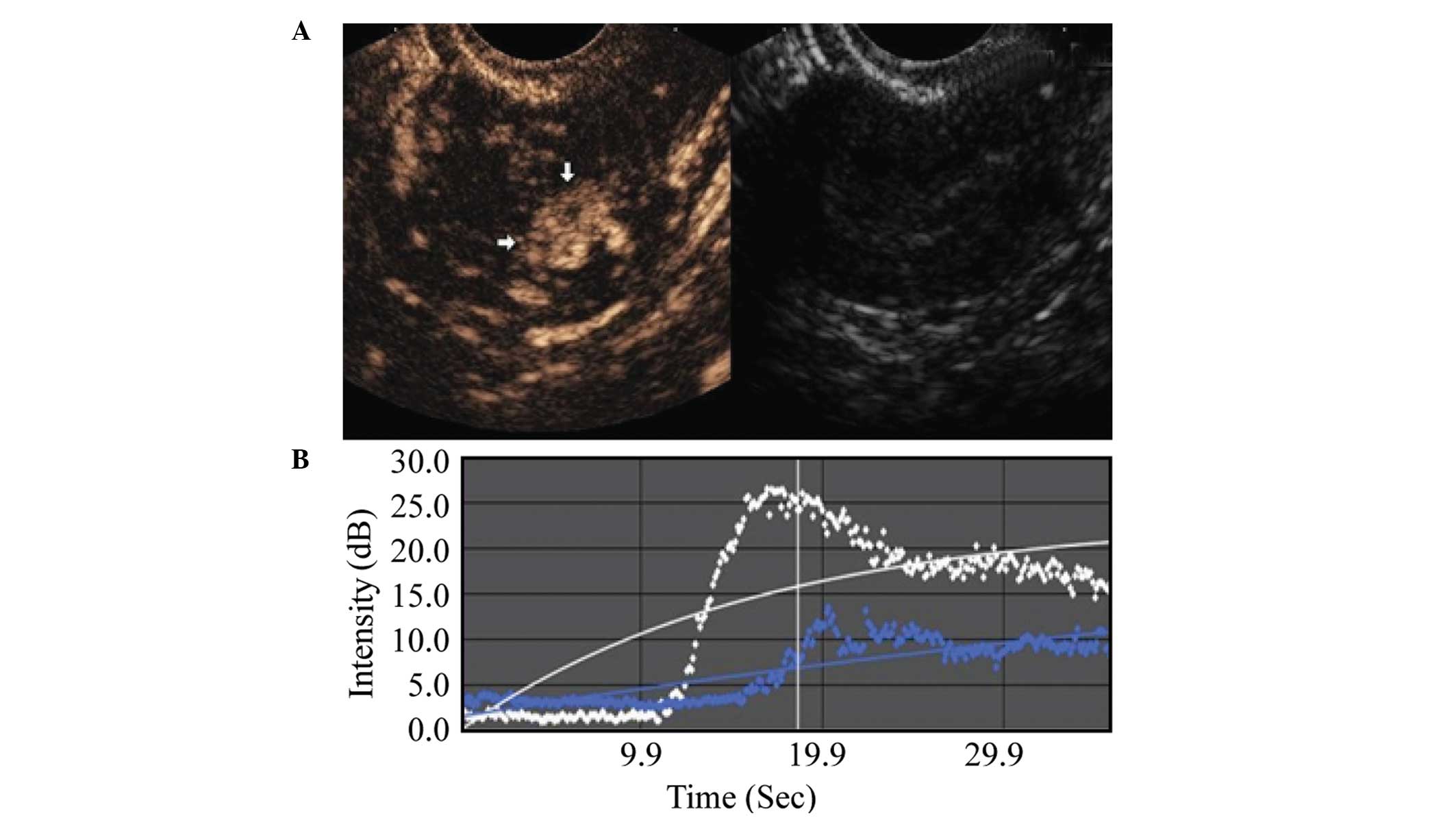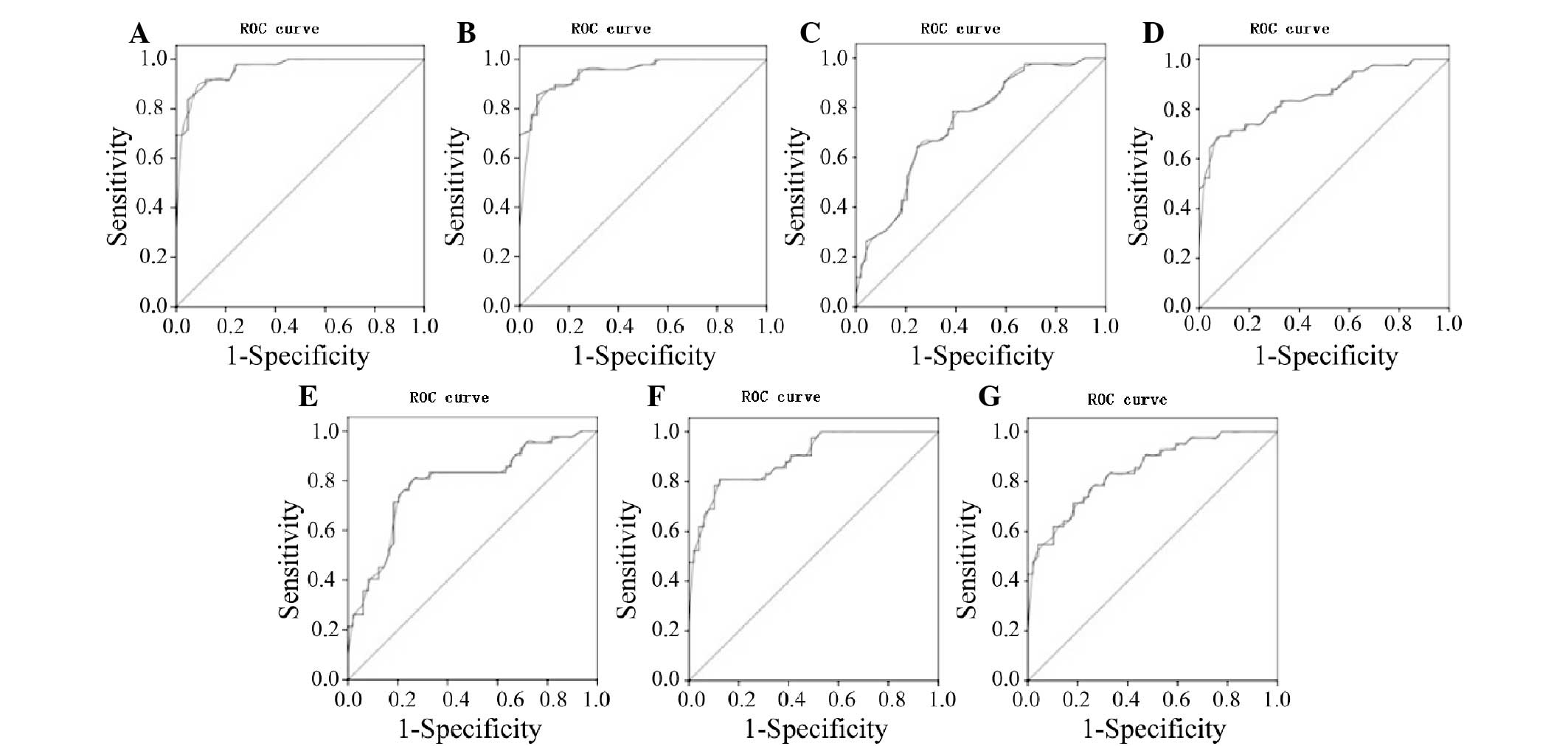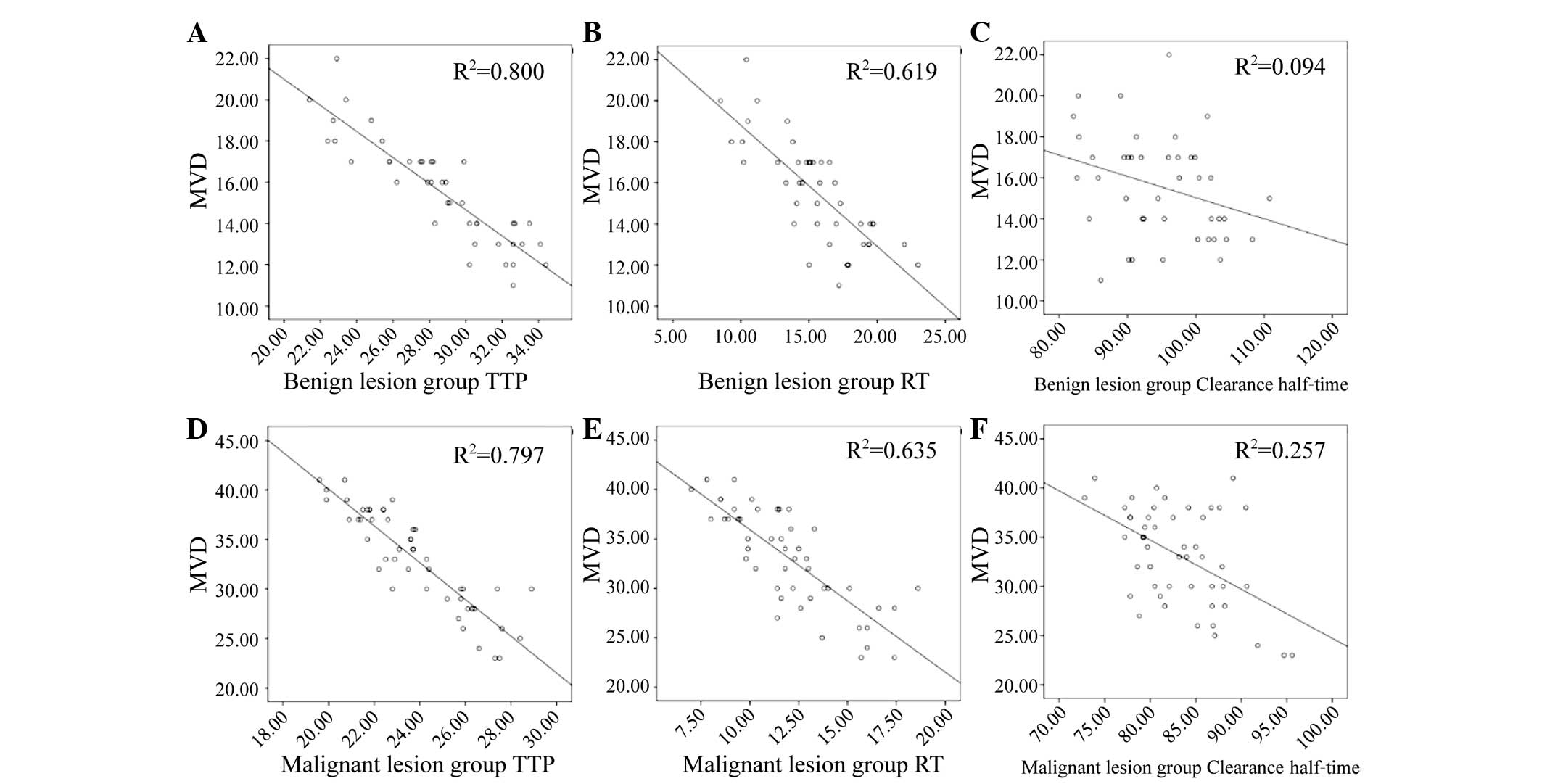Quantitative contrast-enhanced ultrasonography for the differential diagnosis of endometrial hyperplasia and endometrial neoplasms
- Authors:
- Published online on: September 29, 2016 https://doi.org/10.3892/ol.2016.5206
- Pages: 3763-3770
-
Copyright: © Liu et al. This is an open access article distributed under the terms of Creative Commons Attribution License.
Abstract
Introduction
Endometrial diseases are common gynecological conditions that pose a threat to women's health. Improvements in ultrasonography (US) have led to it becoming an important method for differentiating and diagnosing endometrial diseases. In recent years, research and advances in contrast-enhanced US (CEUS) imaging technology have allowed it to be successfully applied in the diagnosis and treatment of liver tumors, and in the diagnosis of cardiovascular, urinary (1–3) and superficial tissue diseases (4). However, its application in the diagnosis of gynecological diseases remains at the experimental stage (5). Preliminary conclusions from studies in China and around the world have shown the value of ultrasound imaging in the diagnosis of gynecological diseases (6). CEUS offers the opportunity to identify endometrial diseases in the static B-scan mode, and to simultaneously assess the capillary microperfusion in the dynamic contrast harmonic imaging mode. Furthermore, a quantitative assessment of microperfusion is possible using time-intensity curve (TIC) analysis (7,8). This is of particular significance, as angiogenesis is an essential factor for tumor growth and metastasis in a range of human tumors, including endometrial cancer (9). Therefore, the study of tumor angiogenesis and MVD may assist in improving the prognosis of cancer patients.
In the present study, CEUS was used for the examination of endometrial lesions. The enhancement characteristics of the diseased areas and changes over a TIC were analyzed. The feasibility of applying CEUS for distinguishing between benign and malignant endometrial lesions investigated and markers that were correlated with the pathological results were screened. This study aimed to analyze CEUS parameters and their association with microvessel density (MVD), as assessed by immunohistochemistry in benign and malignant uterine tumors.
Materials and methods
Subjects
The study group consisted of 91 patients (outpatients and inpatients) who were treated at the Harbin Medical University Cancer Hospital (Harbin, China) between January 2010 and March 2014, and were diagnosed with endometrial disease based on pathological results (gold standard). All pathology samples were obtained via biopsy or surgery. The patients were divided into two groups: A benign endometrial lesion group, including 42 patients with a mean age of 44.83±7.71 years (range, 33–58 years), and a malignant lesion group, including 49 patients with a mean age of 47.36±9.14 years (range, 36–63 years). None of the patients had a history of radiochemotherapy treatment, hypertension, heart disease or drug allergies. After providing written informed consent, the patients underwent an ultrasound examination during the week immediately prior to surgery. This study was conducted in accordance with the declaration of Helsinki and with approval from the Ethics Committee of Harbin Medical University (Harbin, China). Written informed consent was obtained from all participants. A flowchart of the diagnosis and treatment of endometrial diseases in the enrolled patients is shown in Fig. 1.
Equipment
An ACUSON Sequoia™ 512 color ultrasound system (Siemens AG, Munich, Germany) was used to perform Cadence™ contrast pulse sequencing (CPS) and auto contrast quantification, using an EC-10C5 transducer (6–10 MHz) as a transvaginal probe. The equipment settings, which included gain and time-gain compensation, were constant during the imaging process. The mechanical index was kept at 0.10–0.19.
Contrast agent
SonoVue (Bracco, Milan, Italy), a contrast agent mainly consisting of sulfur hexafluoride gas microbubbles with a phospholipid monolayer coating, was diluted prior to use in 5 ml of 0.9% saline, while shaking to obtain a white, milky solution. The concentration of the microbubbles was 1–5×108 ml with a mean bubble diameter of 2.5 µm. The mean in vivo half-life of SonoVue was 12 min. SonoVue was administered as a bolus injection (2.4-ml dose), which was immediately followed by injection of 5 ml saline. If necessary, this procedure was repeated once more with the same dose and method.
Regular ultrasound
All patients underwent a regular ultrasound and CEUS examination during the week immediately prior to surgery.
Transvaginal ultrasound was performed with the patient having an empty bladder. Lesions were first revealed on two-dimensional gray scale images, and the equipment settings (including dynamic range, gain, depth and focus area) were adjusted during the procedure to obtain the best images.
Contrast ultrasound
Following the regular ultrasound, CEUS was performed while the patient's body position remained unchanged. A scanning plane showing the lesion's largest diameter or most abundant blood flow, the lesion and surrounding tissues simultaneously, and the standard long and short axis planes whenever possible, was chosen as the most appropriate plane to display the lesion. The imaging conditions for the contrast pulse sequences were then selected.
The SonoVue solution (2.4 ml) was administered by bolus injection via the ulnar vein, followed by a 5-ml saline flush. Meanwhile, the built-in timer within the ultrasound equipment was turned on, and the continuous real-time evaluation of SonoVue uptake and washout, and echo intensity within the region of interest was conducted. The imaging process took 3–6 min, and the imaging data were stored in the ultrasound equipment built-in hard drive for later analysis by the specialist. Results were compared with those from the regular ultrasound and pathological examinations.
Time-intensity curve (TIC) analysis
The ultrasound equipment built-in auto contrast quantification software automatically examined the images and analyzed the TIC. It selected the appropriate region of interest according to lesion size, and automatically scanned and recorded the TIC. The following parameters were obtained from the TIC analysis: Intensity parameters, including basis intensity (BI), peak intensity (PI) and enhancement intensity (EI = PI - BI); and time parameters, including arrival time (AT), time-to-peak (TTP), rise time (RT; RT = TTP - AT, washout half-time (the time at which the TIC PI decreased to half of its maximal EI) and clearance half-time (RT + washout half-time).
Pathological analyses
The clinical stages of malignant lesions (endometrial carcinoma) were determined according to the standards of the International Federation of Gynecology and Obstetrics (FIGO) revised in 2009 (10). Benign endometrial lesions include endometrial hyperplasia and endometrial polyps, while there is only one type of malignant endometrial lesions (endometrial carcinoma).
For immunohistochemical examination, samples obtained during surgery were paraffin-embedded and sectioned (3–4 µm) prior to immunohistochemical staining using mouse anti-human cluster of differentiation (CD)34 monoclonal antibody (dilution 1:10,000; cat. no. QBEnd/10; Heilongjiang Saishang Technology and Development Co., Harbin, China). Brown staining of the vascular endothelial cell cytoplasm was considered indicative of CD34-positivity. The standard Weidner's method (11) was used for microvessel counting and the mean count was considered as the MVD value in each sample.
Statistical analyses
The SPSS version 17.0 software package (SPSS, Inc., Chicago, IL, USA) was used for data analysis. The data are expressed as the mean ± standard deviation. Continuous quantitative variables were compared using an analysis of variance or Student's t-test. The cut-off values for the diagnosis were obtained from the receiver operating characteristic (ROC) curve. Correlations were calculated using Pearson's χ2 test. P<0.05 was considered to indicate a statistically significant difference.
Results
TIC parameters
Comparison between the malignant and benign lesion groups showed that the malignant lesion regions exhibited an earlier AT, shorter RT, shorter TTP, higher PI, higher EI, as well as a shorter washout and clearance half-time during the imaging examination. These differences were statistically significant (P<0.001), as shown in Table I, and in Figs. 2 and 3.
Table I.Comparison of contrast-enhanced ultrasonography time-intensity curve parameters between the malignant and benign endometrial lesion groups. |
Analysis of ROC curve
A ROC curve analysis was used to determine the diagnostic values of all the TIC parameters obtained during the ultrasound for the benign and malignant endometrial lesion groups, as shown in Fig. 4. A comparative analysis of the AUC in the two groups showed an AUC for BI of 0.5, which was not statistically significant. The AUCs for the PI and EI parameters were relatively high (0.963 and 0.951, respectively), while the other parameters showed some degree of accuracy.
The maximum sum of the sensitivity and specificity was chosen as the critical value. According to the ROC curve, the PI, EI, AT, PT, RT, washout half-time and clearance half-time values of the endometrial malignant lesions were 29.2 dB, 21.35 dB, 12.75 sec, 26.75 sec, 13.2 sec, 89.3 sec and 75.45 sec, respectively. The PI and EI of the lesions were equal to or greater than the cut-off values, whereas the corresponding AT, PT, RT, washout half-time and clearance half-time were equal to or less than the cut-off values, suggesting malignancy. Diagnosis rates are summarized in Table II.
Table II.Sensitivities and specificities of the receiver operating characteristic curve between benign and malignant endometrial lesion groups. |
Correlation between ultrasound TIC and MVD immunohistochemistry results
The MVD in benign and malignant lesions was examined using immunohistochemical staining. The MVD in the malignant group was significantly higher (33.10±4.98) than that in the benign group (15.57±2.54) (P<0.01).
In the two groups, AT, RT and clearance half-time were negatively correlated with MVD (Table III), i.e., the higher the MVD, the lower the values of AT, RT and clearance half-time (Fig. 5A-F).
Table III.Time-intensity curve parameters correlated with MVD for the benign and malignant lesion groups. |
Discussion
In recent years, the rapid development of CEUS technology has enriched the evaluation parameters of ultrasound images and greatly improved the quality of ultrasound diagnoses (12). Additionally, a new generation of contrast agents has allowed the highly accurate detection of blood vessels and the quantitative analysis of blood perfusion (13).
US has been widely used in the diagnosis of numerous diseases (14). The most important application of CEUS has been in the diagnosis of all types of benign and malignant tumors. Currently, the most advanced and widespread application of CEUS is in the diagnosis and identification of benign and malignant liver lesions (15), but its application in the diagnosis of lesions in other organs has not been widely studied (16). However, preliminary and satisfactory advances have been made in the study of tumors of the pancreas, kidneys, prostate, female reproductive organs, breasts, glands and thyroid.
The application of CEUS in gynecology has become widespread (17) and mainly includes studies of ovarian tumor morphology and TIC parameters, and the differential diagnosis of leiomyoma and adenomyosis (18). Testa et al evaluated the results of CEUS and compared them with those of the pathological examination in 24 patients with cervical cancer (19). The results showed that among 19 cases with invasive cervical cancer, no abnormalities were detected by regular ultrasound in 9 cases, whereas an enlarged cervix or a cervical tumor with unclear boundaries was observed in 10 cases. By contrast, CEUS has revealed a highly homogeneous or heterogeneous enhancement during the early phase, low enhancement during the late phase, and blurry boundaries between the lesion and surrounding tissues (20). This means that CEUS was able to show abnormal blood flow signals within the lesion area, enhance the echo differences between the lesion area and the surrounding tissues, and clearly identify the lesion range, location and boundaries, facilitating the diagnosis of cervical cancer (21). In addition, CEUS was also able to evaluate the extent of infiltration, and as such, it may provide valuable information for clinical staging and treatment planning (22).
The present study applied CEUS-CPS technology not only to visually inspect gray-scale dynamic images of benign and malignant tumors to provide a preliminary qualitative diagnosis, but also to quantitatively analyze their TICs. CEUS represents an objective method to aid the differential diagnosis of benign and malignant endometrial tumors (23). The present results showed that the TIC of endometrial malignancy revealed an early and quick enhancement during the initial phase, as evidenced by its steepness, sharpness and high magnitude of peaks, and decreased unidirectionally during the later phase (24). The overall TIC displayed a quick rise-quick decline profile, with a short AT and PT, high EI, and short washout and clearance half-times. By contrast, the TIC of benign endometrial lesions increased slowly showing blunt peaks during the initial phase and declined slowly during the later phase (25). The overall curve had a slow rise-slow decline profile, with longer AT and PT, lower EI, and longer washout and clearance half-times, compared with the endometrial malignancy TIC. Comparison of the TIC parameters between malignant and benign endometrial lesions showed that differences observed in the time parameters (AT, PT, RT, and washout and clearance half-times) and the intensity parameters (PI and EI) between the two groups were statistically significant.
The present study also compared and analyzed the diagnostic capacity of all the time and intensity parameters using ROC curve analysis (26). ROC uses the false-positive rate (1-specificity) as the x-axis, and sensitivity as the y-axis, to generate the curve. With this configuration, clinical diagnostic accuracy and treatment efficacy can be evaluated. It is statistically simple, quick and straightforward for evaluating diagnostic tests (27). Meanwhile, the best cut-off can also be calculated according to the ROC. In this study, the TIC ROC of benign and malignant lesions showed that all the parameters had middle-level diagnostics capacity, and therefore showed certain values when differentiating between the benign and malignant endometrial lesions. Overall, PI and EI were more consistent with the truth.
Several intermediate steps occur during the transformation of a benign lesion into a well-differentiated endometrial cancer (28), with malignant lesions usually being highly vascularized. CEUS can detect the formation of new blood vessels during tumor angiogenesis, thus predicting blood vessel changes within tumor tissues prior to morphological changes occurring (29). Moreover, the accurate detection of microvessel changes using CEUS aids the early diagnosis of endometrial carcinoma, with improved sensitivity and specificity. Therefore, the CEUS-TIC can quantitatively and indirectly evaluate tumor angiogenesis in vivo. In addition, a correlation between the TIC and MVD of benign and malignant endometrial lesions can be used to differentiate between tumor benignity and malignancy prior to surgery, to evaluate the degree of tumor differentiation and to predict prognosis in endometrial carcinoma patients. Having this knowledge assists the medical team in developing a sounder personal treatment plan that fits the individual patient. To date, there have not been enough studies that have examined the correlation between CEUS results and MVD in patients with endometrial diseases (30). The present study found distinct differences in MVD between benign and malignant lesions, i.e., MVD was significantly higher in malignant lesions than in benign lesions (31). As MVD is closely correlated with blood supply in the lesion area, an enhanced MVD indicates an increase in the blood supply to a malignant lesion (32). In the benign and malignant endometrial lesion groups, the AT, RT and clearance half-time were all negatively correlated with MVD, i.e., the higher the MVD, the shorter the AT, RT and clearance half-time.
In summary, the present CEUS results reflected the characteristics of the blood circulation relevant to benign and malignant endometrial lesions. Moreover, analysis of the enhancement and clearance of the contrast agent aided in the differentiation between benign and malignant lesions within the endometrium. Therefore, CEUS-TIC can be used to quantitatively analyze the intake and washout of the contrast agent in the lesion area, and to differentially diagnose benign and malignant endometrial lesions by determining the TIC parameters. Furthermore, the PT, RT and clearance half-time on the CEUS-TIC demonstrated a clear correlation with the MVD immunohistochemistry results. Hence, as CEUS may indirectly reflect the angiogenesis process within the lesion, it may provide a novel method for the pre-operative differentiation of benign and malignant lesions.
References
|
Correas JM, Bridal L, Lesavre A, Méjean A, Claudon M and Hélénon O: Ultrasound contrast agents: Properties, principles of action, tolerance and artifacts. Eur Radiol. 11:1316–1328. 2001. View Article : Google Scholar : PubMed/NCBI | |
|
Dong XQ, Shen Y, Xu LW, Xu CM, Bi W and Wang XM: Contrast-enhanced ultrasound for detection and diagnosis of renal clear cell carcinoma. Chin Med J (Engl). 122:1179–1183. 2009.PubMed/NCBI | |
|
Lang SA, Moser C, Gehmert S, Pfister K, Hackl C, Schnitzbauer AA, Stroszczynski C, Schlitt HJ, Geissler EK and Jung EM: Contrast-enhanced ultrasound (CEUS) detects effects of vascular disrupting therapy in an experimental model of gastric cancer. Clin Hemorheol Microcirc. 56:287–299. 2014.PubMed/NCBI | |
|
Wei X, Li Y, Zhang S, Li X, Wang H, Yong X, Wang X, Li X and Gao M: Evaluation of microvascularization in focal salivary gland lesions by contrast-enhanced ultrasonography (CEUS) and Color Doppler sonography. Clin Hemorheol Microcirc. 54:259–271. 2013.PubMed/NCBI | |
|
Kearor CS, Lindner JR, Belcik JT, Bishop CV and Slayden OD: Contrast-enhanced ultrasound reveals real-time spatial changes in vascular perfusion during early implantation in the macaque uterus. Fertil Steril. 95:1316–1321.e1-3. 2011. View Article : Google Scholar : PubMed/NCBI | |
|
Liu Y, Tian JW, Xu Y and Cheng W: Role of transvaginal contrast-enhanced ultrasound in the early diagnosis of endometrial carcinoma. Chin Med J (Engl). 125:416–421. 2012.PubMed/NCBI | |
|
Fellner C, Prantl L, Rennert J, Stroszczynski C and Jung EM: Comparison of time-intensity-curve-(TIC-) analysis of contrast-enhanced ultrasound (CEUS) and dynamic contrast-enhanced (DCE) MRI for postoperative control of microcirculation in free flaps-first results and critical comments. Clin Hemorheol Microcirc. 48:187–198. 2011.PubMed/NCBI | |
|
Geis S, Gehmert S, Lamby P, Zellner J, Pfeifer C, Prantl L and Jung EM: Contrast enhanced ultrasound (CEUS) and time intensity curve (TIC) analysis in compartment syndrome: First results. Clin Hemorheol Microcirc. 50:1–11. 2012.PubMed/NCBI | |
|
Wang Y, Li L, Wang YX, Cui NY, Zou SM, Zhou CW and Jiang YX: Time-intensity curve parameters in rectal cancer measured using endorectal ultrasonography with sterile coupling gels filling the rectum: Correlations with tumor angiogenesis and clinicopathological features. Biomed Res Int. 2014:5878062014. View Article : Google Scholar : PubMed/NCBI | |
|
Pecorelli S: Revised FIGO staging for carcinoma of the vulva, cervix, and endometrium. International Int J Gynaecol Obstet. 105:103–104. 2009. View Article : Google Scholar | |
|
Weidner N, Semple JP, Welch WR and Folkman J: Tumor angiogenesis and metastasis-correlation in invasive breast carcinoma. N Engl J Med. 324:1–8. 1991. View Article : Google Scholar : PubMed/NCBI | |
|
Fischerova D: Ultrasound scanning of the pelvis and abdomen for staging of gynecological tumors: A review. Ultrasound Obstet Gynecol. 38:246–266. 2011. View Article : Google Scholar : PubMed/NCBI | |
|
Steppan I, Reimer D, Müller-Holzner E, Marth C, Aigner F, Frauscher F, Frede T and Zeimet AG: Breast cancer in women: Evaluation of benign and malignant a axillary lymph nodes with contrast-enhanced ultrasound. Ultraschall Med. 31:63–67. 2010.(In English, German). View Article : Google Scholar : PubMed/NCBI | |
|
Xu HX: Contrast-enhanced ultrasound: The evolving applications. World J Radiol. 1:15–24. 2009. View Article : Google Scholar : PubMed/NCBI | |
|
Claudon M, Dietrich CF, Choi BI, Cosgrove DO, Kudo M, Nolsøe CP, Piscaglia F, Wilson SR, Barr RG, Chammas MC, et al: Guidelines and good clinical practice recommendations for contrast enhanced ultrasound (CEUS) in the liver-update 2012: A WFUMB-EFSUMB initiative in cooperation with representatives of AFSUMB, AIUM, ASUM, FLAUS and ICUS. Ultrasound Med Biol. 39:187–210. 2013. View Article : Google Scholar : PubMed/NCBI | |
|
Cosgrove D and Lassau N: Imaging of perfusion using ultrasound. Eur J Nucl Med Mol Imaging. 37(Suppl 1): S65–S85. 2010. View Article : Google Scholar : PubMed/NCBI | |
|
Poret-Bazin H, Simon EG, Bleuzen A, Dujardin PA, Patat F and Perrotin F: Decrease of uteroplacental blood flow after feticide during second-trimester pregnancy termination with complete placenta previa: Quantitative analysis using contrast-enhanced ultrasound imaging. Placenta. 34:1113–1115. 2013. View Article : Google Scholar : PubMed/NCBI | |
|
Dutta S, Wang FQ, Fleischer AC and Fishman DA: New frontiers for ovarian cancer risk evaluation: Proteomics and contrast-enhanced ultrasound. AJR Am J Roentgenol. 194:349–354. 2010. View Article : Google Scholar : PubMed/NCBI | |
|
Testa AC, Ferrandina G, Fruscella E, Van Holsbeke C, Ferrazzi E, Leone FP, Arduini D, Exacoustos C, Bokor D, Scambia G and Timmerman D: The use of contrasted transvaginal sonography in the diagnosis of gynecologic diseases: A preliminary study. J Ultrasound Med. 24:1267–1278. 2005.PubMed/NCBI | |
|
Balleyguier C, Opolon P, Mathieu MC, Athanasiou A, Garbay JR, Delaloge S and Dromain C: New potential and applications of contrast-enhanced ultrasound of the breast: Own investigations and review of the literature. Eur J Radiol. 69:14–23. 2009. View Article : Google Scholar : PubMed/NCBI | |
|
Xiang H, Huang R, Cheng J, Gulinaer S, Hu R, Feng Y and Liu H: Value of three-dimensional contrast-enhanced ultrasound in the diagnosis of small adnexal masses. Ultrasound Med Biol. 39:761–768. 2013. View Article : Google Scholar : PubMed/NCBI | |
|
Zhang XL, Zheng RQ, Yang YB, Huang DM, Song Q, Mao YJ, Li YH and Zheng ZJ: The use of contrast-enhanced ultrasound in uterine leiomyomas. Chin Med J (Engl). 123:3095–3099. 2010.PubMed/NCBI | |
|
Zhu Y, Chen Y, Jiang J, Wang R, Zhou Y and Zhang H: Contrast-enhanced harmonic ultrasonography for the assessment of prostate cancer aggressiveness: A preliminary study. Korean J Radiol. 11:75–83. 2010. View Article : Google Scholar : PubMed/NCBI | |
|
Arthuis CJ, Novell A, Escoffre JM, Patat F, Bouakaz A and Perrotin F: New insight into uteroplacental perfusion: Quantitative analysis using Doppler and contrast-enhanced ultrasound imaging. Placenta. 34:424–431. 2013. View Article : Google Scholar : PubMed/NCBI | |
|
Aoki S, Hattori R, Yamamoto T, Funahashi Y, Matsukawa Y, Gotoh M, Yamada Y and Honda N: Contrast-enhanced ultrasound using a time-intensity curve for the diagnosis of renal cell carcinoma. BJU Int. 108:349–354. 2011. View Article : Google Scholar : PubMed/NCBI | |
|
Xu M, Xie XY, Liu GJ, Xu HX, Xu ZF, Huang GL, Chen PF, Luo J and Lü MD: The application value of contrast-enhanced ultrasound in the differential diagnosis of pancreatic solid-cystic lesions. Eur J Radiol. 81:1432–1437. 2012. View Article : Google Scholar : PubMed/NCBI | |
|
Salvatore V, Borghi A, Sagrini E, Galassi M, Gianstefani A, Bolondi L and Piscaglia F: Quantification of enhancement of focal liver lesions during contrast-enhanced ultrasound (CEUS). Analysis of ten selected frames is more simple but as reliable as the analysis of the entire loop for most parameters. Eur J Radiol. 81:709–713. 2012. View Article : Google Scholar : PubMed/NCBI | |
|
Czekierdowski A, Czekierdowska S, Czuba B, Cnota W, Sodowski K, Kotarski J and Zwirska-Korczala K: Microvessel density assessment in benign and malignant endomerrial changes. J Physiol Pharmacol. 59(Suppl 4): S45–S51. 2008. | |
|
Badea AF, Tamas-Szora A, Clichici S, Socaciu M, Tăbăran AF, Băciut G, Cătoi C, Mureşan A, Buruian M and Badea R: Contrast enhanced ultrasonography (CEUS) in the characterization of tumor microcirculation. Validation of the procedure in the animal experimental model. Med Ultrason. 15:85–94. 2013. View Article : Google Scholar : PubMed/NCBI | |
|
Shiyan L, Pintong H, Zongmin W, Fuguang H, Zhiqiang Z, Yan Y and Cosgrove D: The relationship between enhanced intensity and microvessel density of gastric carcinoma using double contrast-enhanced ultrasonography. Ultrasound Med Biol. 35:1086–1091. 2009. View Article : Google Scholar : PubMed/NCBI | |
|
Wang J, Lv F, Fei X, Cui Q, Wang L, Gao X, Yuan Z, Lin Q, Lv Y and Liu A: Study on the characteristics of contrast-enhanced ultrasound and its utility in assessing the microvessel density in ovarian tumors or tumor-like lesions. Int J Biol Sci. 7:600–666. 2011. View Article : Google Scholar : PubMed/NCBI | |
|
Fleischer AC, Lyshchik A, Jones HW III, Crispens MA, Andreotti RF, Williams PK and Fishman DA: Diagnostic parameters to differentiate benign from malignant ovarian masses with contrast-enhanced transvaginal sonography. J Ultrasound Med. 28:1273–1280. 2009.PubMed/NCBI |



